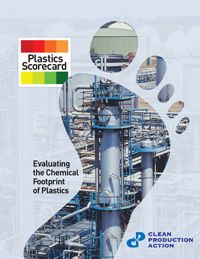Jul 4 2014
By switching the type of plastic used in its IV bags, Dignity Health care system kept 700,000 pounds of high-concern chemicals – the equivalent in weight of a Boeing 747 airplane -- out of the environment, according to a new analysis that measures the "chemical footprint" of plastics.

The data were released today along with a new report, Plastics Scorecard v.1.0, which offers the first comprehensive method for assessing and reducing chemicals of high concern in plastics.
“From baby bottles made with BPA to medical devices made with DEHP, plastics are a surprising source of exposure to chemicals of high concern to human health and the environment,” said Ann Blake, PhD, co-author of the report and Principal at Environmental & Public Health Consulting. “Forward looking businesses are looking closely at plastics for chemicals that may be subject to future regulations or consumer scrutiny.”
The Plastics Scorecard was designed as a tool to help purchasers choose safer plastics, and catalyze manufacturers to reduce the number and volume of chemicals of high concern used in manufacturing plastics and in the plastic products themselves.
“Plastics are possibly the largest contributor of any material to the toxic chemical economy. For example, plastics consume 96% of global Bisphenol A (BPA) production,” said Mark Rossi, PhD, co-director of Clean Production Action and co-author of the report. “If we are ever to attain a green chemistry economy, we need to shift plastics manufacturing to chemicals of low concern to human health and the environment.”
The Plastics Scorecard evaluates plastics based on their Manufacturing Score and Product Footprint.
The “Progress to Safer Chemicals in Manufacturing Score” evaluates plastic polymers on a scale from 0 (most hazards) to 100 (most benign). In evaluating 10 polymers, the report found:
- 5 commonly used polymers score 0 due to the intensive use of high-concern chemicals at every step of manufacturing. These are polyvinyl chloride (PVC), polycarbonate (PC), polystyrene (PS), styrene butadiene rubber (SBR) and acrylonitrile butadiene styrene (ABS).
- 3 polymers -- polylactic acid (PLA), polyethylene (PE) and polypropylene (PP) -- are much further along the path to safer chemicals, because their core inputs are not chemicals of high concern.
- 2 polymers – polyethylene terephthalate (PET) and ethylene vinyl acetate (EVA) -- are in the mid range.
The Product Footprint measures the number and weight percentage of high-concern chemicals in plastic products. The report found that by switching to safer plastics or additives, manufacturers of IV bags and electronics can sell products with a significantly lower chemical footprint.
For example, by switching from PVC to non-PVC IV bags, health organizations are significantly reducing their use of reproductive/developmental toxicants and endocrine disruptors because PVC IV bags typically contain 30% DEHP and 0.5% BPA by weight.
“We’re proud that our switch to non-PVC IV bags removed roughly 673,000 pounds of DEHP and 34,000 pounds of BPA from the market over the past six years. This is the direction we need to move for the health of workers, patients, and communities,” said Mary Ellen Leciejewski, Director of Ecology, from Dignity Health.
The Plastics Scorecard lays out a five-step program for companies seeking to reduce the chemical footprint of their plastics:
- First, ask if a chemical additive or plastic is even necessary for the product.
- Use safer additives for plastic products and avoid chemicals of high concern.
- Use safer polymers to reduce chemicals of high concern in manufacturing.
- Close the loop by using post-consumer recycled content, but beware of legacy toxic chemicals.
- Redesign the product to eliminate additives and/or plastics altogether.
For more information about how to reduce the chemical footprint of plastics, see www.bizngo.org/sustainable-materials/plastics-scorecard.
What Businesses and NGOs are saying about the Plastics Scorecard
Roger McFadden, Vice President and Senior Scientist, Staples, Inc.: “Clean Production Action is delivering the tools needed to create benchmarks for progress towards safer chemicals and more sustainable materials in a doable and pragmatic way that any business can use. The Plastics Scorecard is an easy to use metric for identifying plastic products with a smaller chemical footprint.”
Helen Holder, Material Strategist, HP: “The analyses of polymers and chemicals in this report provide valuable insights as we consider potential materials and technologies, and can help us identify alternatives with a reduced risk of potential human health and environmental impacts.”
Howard Williams, Senior Vice President Sustainability & Acquisitions, Construction Specialties: “We make decisions based on concerns for human health and the environment. We want to know the chemicals contained in our materials and their hazard characteristics. We call on the plastics industry to embed the Plastics Scorecard into new material development.”
Barry Cik, Co-Founder, Naturepedic: “The Plastics Scorecard demonstrates the ability of business and environmental health leaders to collaborate for the development of a clear roadmap to producing products with safer chemicals and sustainable plastics. Together, we are advancing the innovative thinking that is crucial to truly transform our chemicals and materials economy in the 21st century."
Charlotte Brody, Vice President of Health Initiatives, BlueGreen Alliance: “The Plastics Scorecard pays attention to the exposure of workers in its chemical footprinting of plastics. So the Scorecard will be an important resource for the BlueGreen Alliance and the plastics manufacturing workforce in its membership. Plastics workers have elevated levels of breast cancer and other chronic diseases. So the sooner we have inherently safer chemicals in workplaces the better for workers and society.”
Ken Geiser, author of Materials Matter, and professor emeritus, University of Massachusetts Lowell: “The Plastics Scorecard provides a valuable new tool for assessing the safety and sustainability of the materials that we use. Progressive businesses interested in using truly sustainable materials will want to use the Plastics Scorecard to evaluate the chemical footprint of their plastic products.”
Contact:
Mark Rossi, 781.799.9504 [email protected]
Stacy Malkan, 510.542.9224 [email protected]